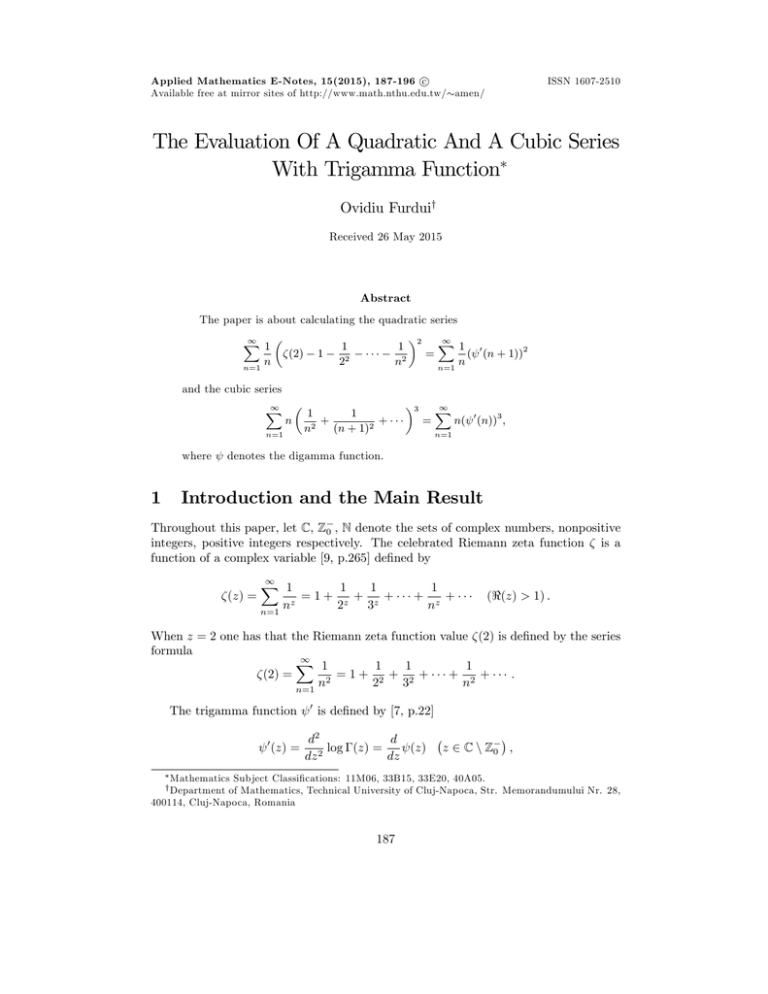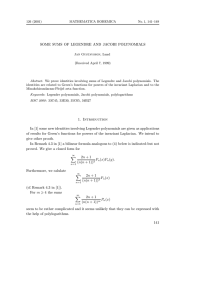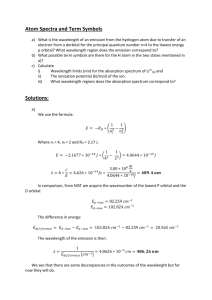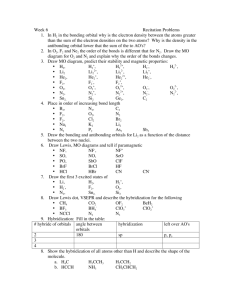Document 10677580
advertisement

Applied Mathematics E-Notes, 15(2015), 187-196 c Available free at mirror sites of http://www.math.nthu.edu.tw/ amen/ ISSN 1607-2510 The Evaluation Of A Quadratic And A Cubic Series With Trigamma Function Ovidiu Furduiy Received 26 May 2015 Abstract The paper is about calculating the quadratic series 1 X 1 n n=1 (2) 1 1 22 1 n2 2 = 1 X 1 ( n n=1 0 (n + 1))2 and the cubic series 1 X n n=1 where 1 1 1 + + n2 (n + 1)2 3 = 1 X n( 0 (n))3 ; n=1 denotes the digamma function. Introduction and the Main Result Throughout this paper, let C, Z0 , N denote the sets of complex numbers, nonpositive integers, positive integers respectively. The celebrated Riemann zeta function is a function of a complex variable [9, p.265] de…ned by (z) = 1 X 1 1 1 =1+ z + z + z n 2 3 n=1 + 1 + nz (<(z) > 1) : When z = 2 one has that the Riemann zeta function value (2) is de…ned by the series formula 1 X 1 1 1 1 (2) = =1+ 2 + 2 + + 2+ : 2 n 2 3 n n=1 The trigamma function 0 (z) = 0 is de…ned by [7, p.22] d2 d log (z) = (z) dz 2 dz z 2 C n Z0 ; Mathematics Subject Classi…cations: 11M06, 33B15, 33E20, 40A05. of Mathematics, Technical University of Cluj-Napoca, Str. Memorandumului Nr. 28, 400114, Cluj-Napoca, Romania y Department 187 188 The Evaluation of a Quadratic and a Cubic Series 0 (z) d (z) being the (or digamma) function de…ned by (z) = dz log (z) = (z) or, in terms of the generalized (or Hurwitz) zeta function (s; a) de…ned by (s; a) := 1 P 1 <(s) > 1; a 2 C n Z0 , (k+a)s k=0 0 (z) = 1 X k=0 1 = (2; z) (k + z)2 z 2 C n Z0 : This implies that 0 (n) = 1 1 + + n2 (n + 1)2 = (2) 1 22 1 1 (n 1)2 (n 2 N n f1g) : Closed form evaluation of series involving (k) are collected in [7] and, more recently, in [8]. Other series, linear or quadratic, involving the Riemann zeta function and harmonic numbers, which are evaluated in terms of special constants can be found in [4]. In this paper we evaluate a quadratic and a cubic series involving the tail of (2). More precisely, we calculate the quadratic series 1 X 1 n n=1 (2) 1 1 22 2 1 n2 1 X 1 0 ( (n + 1))2 = n n=1 and the cubic series 1 X 1 1 + + n2 (n + 1)2 n n=1 3 = 1 X n( 0 (n))3 ; n=1 where denotes the digamma function. The main result of this paper is the following theorem. THEOREM 1 (A quadratic and a cubic series with the tail of (2)). The following identities hold: (a) (b) P1 1 n=1 n P1 n=1 n (2) 0 (n) 1 3 = 1 2 n2 1 22 9 2 (3) 17 8 = 5 (2) (3) (4) 25 4 (5) + 9 2 9 (5); (2) (3). We need in our analysis Abel’s summation formula [1, p.55], [4, p.258] which states that Pn if (an )n 1 and (bn )n 1 are two sequences of real or complex numbers and An = k=1 ak , then n X k=1 ak bk = An bn+1 + n X k=1 Ak (bk bk+1 ) (n 2 N) : O. Furdui 189 We will also use, in our calculations, the in…nite version of the preceding formula: 1 X ak bk = lim (An bn+1 ) + n!1 k=1 1 X Ak (bk bk+1 ); (1) k=1 provided the in…nite series on the right hand side of (1) converges and the limit is …nite. A special function which is used in the proof of part (a) of Theorem 1 is the Dilogarithm function. Recall that the Dilogarithm function Li2 is de…ned, for jzj 1, by [7, p.106] Z z 1 X ln(1 t) zn = dt: Li2 (z) = 2 n t 0 n=1 In particular, Li2 (1) = (2). A special identity involving the Dilogarithm function is the following Landen type formula: (2) Li2 (1 z) ln z ln(1 z) = Li2 (z); (2) whose proof can be found in [7, p.107]. 2 Proof of the Main Result In this section we collect some results we need for proving Theorem 1. LEMMA 1 (Some logarithm and polylogarithm integrals). The following equalities hold: (a) (b) (c) (d) (e) R1 0 R1 0 R1 0 R1 0 R1 0 x ln x 1 x dx =1 ln x ln(1 x) dx x (2); = (3); Li2 (x) x dx = (3); Li22 (x) x dx = 2 (2) (3) ln x ln(1 x)Li2 (x) dx x 3 (5); = (2) (3) 3 2 (5). PROOF. (a) We have Z 0 1 x ln x dx 1 x = Z 1 x ln x 0 = 1 X n=0 1 X x n ! 1 =1 (n + 2)2 n=0 dx = 1 Z X n=0 (2): 0 1 xn+1 ln xdx 190 The Evaluation of a Quadratic and a Cubic Series (b) We have Z 1 0 ln x ln(1 x x) dx Z = 1 0 = 1 X xn n n=1 ln x x Z 1 X 1 1 n x n 0 n=1 1 ! dx ln xdx = (3): (c) We have Z 0 1 Z Li2 (x) dx = x 1 0 1 x 1 X xn n2 n=1 ! dx = Z 1 1 X 1 xn 2 n 0 n=1 1 dx = (3): The integrals in parts (d) and (e) are recorded in [3, Entry 1, Table 2, p.1435, Entry 2, Table 6, p.1436]. The next lemma is about calculating two Euler series and a quadratic series involving the tail of (2). LEMMA 2. The following equalities hold: P1 1 1 (a) + n12 = 92 (5) + 3 (2) (3); n=1 n3 1 + 22 + P1 1 1 (b) + n12 = 74 (4); n=1 n2 1 + 22 + (c) P1 n=1 (2) 1 1 2 n2 1 22 5 2 = 3 (3) (4). PROOF. (a) This part of the lemma is a special case of a more general result concerning the evaluation of Euler type series [2, Theorem 3.1, p.22]. (b) We apply Abel’s summation formula (1) with an = n12 and bn = 1+ 212 + + n12 . We have s = = 1 X 1 n2 n=1 lim n!1 1 X 1+ 1 + 22 1+ 1+ 1 + 22 + 1 (n + 1)2 n=1 1+ 1 + 22 1 (n + 1)2 n=1 = 2 = 2 = (2) 1 n2 1 n2 1+ 1 + 22 + 1 X + (2) s + 1 + (4) 7 (4) s; 2 1 1 + 22 + 1 (n + 1)2 1 n2 + 1 (n + 1)2 + 1 X 1 (n + 1)4 n=1 O. Furdui 191 and part (b) of the lemma is proved. 2 4 We used that 2 (2) = 52 (4) since (2) = 6 and (4) = 90 [6, p.605]. (c) The evaluation of this quadratic series involving the tail of (2) can be found in [4, Problem 3.22, p.142], [5, Theorem 1, (a)]. Now we are ready to prove Theorem 1. PROOF. (a) First we note that if k > 0 is a real number then Z 1 xk 1 1 ; k2 ln x dx = 0 and this implies that (2) 1 1 22 1 n2 = = 1 X 1 (n + m)2 m=1 Z 1 1 X xn+m m=1 Z = 1 X 1 n x ln x 0 Z = 1 ln x dx 0 x m=1 1 0 xn 1 x m 1 ! dx ln x dx: It follows that 1 X 1 n n=1 T (2) 1 1 22 1 n2 2 Z 1 n Z 1 n 1 X 1 y x = ln x dx ln y dy n 1 x 1 y 0 0 n=1 Z 1Z 1 Z 1Z 1 1 X (xy)n ln x ln y ln x ln y ln(1 xy) = dxdy = dxdy: x)(1 y) n=1 n (1 x)(1 y) 0 0 0 (1 0 We have I= Z 1 0 Z 0 1 ln x ln y ln(1 xy) dxdy = (1 x)(1 y) Z 0 1 ln x 1 x Z 1 0 ln y ln(1 xy) dy dx: 1 y We calculate the inner integral by parts, with f (y) = ln(1 0 g (y) = Z 0 1 ln y 1 y, g(y) = ln y ln(1 xy) dy 1 y ln y ln(1 y) xy), f 0 (y) = Li2 (y), and we have y=1 = ln(1 xy)(ln y ln(1 y) + Li2 (y)) y=0 x 1 xy , 192 The Evaluation of a Quadratic and a Cubic Series Z 0 = 1 x 1 (ln y ln(1 xy (2) ln(1 Z x) y) + Li2 (y)) dy 1 x 1 0 (ln y ln(1 xy y) + Li2 (y)) dy: It follows, based on part (b) of Lemma 1, that I = (2) Z 1 Z 1 ln x ln(1 x) dx 1 x 0 1 0 0 = Z (1 (2) (3) x ln x (ln y ln(1 y) + Li2 (y)) dxdy x)(1 xy) Z 1Z 1 x ln x (ln y ln(1 y) + Li2 (y)) dxdy: (1 x)(1 xy) 0 0 We calculate the double integral as follows J = = Z 1 Z 1 x ln x (ln y ln(1 x)(1 xy) 0 0 Z 1 Z 1 (ln y ln(1 y) + Li2 (y)) (1 0 0 y) + Li2 (y)) dxdy x ln x dx dy: x)(1 xy) (1 Using part (a) of Lemma 1 the inner integral becomes Z 0 1 x ln x dx x)(1 xy) (1 = Z = 1 0 ln x dx 1 xy 1 1 1 = Z x ln x 1 y Z 1 0 = Using the substitution 1 1 y 0 1 1 y x x ln x dx 1 x 1 xy 1 dx Z 1 xy ln x dx xy 0 1 Z 1 Z 1 ln x dx ln xdx 1 xy 0 0 1 y 1 (2) + 1 y 1 y Z 1 (2) 1 ln x dx: 1 y 1 y 0 1 xy xy = t; we get that = = 1 y 1 y Z 1 y ln(1 1 Z 1 y 1 t) t ln y ln(1 t) dt t dt ln y ln(1 y) : On the other hand, Z 1 1 y ln(1 t) dt t = = Z Z 1 ln(1 t) ln(1 t) dt dt t t 0 0 Li2 (1 y) + Li2 (1) 1 y O. Furdui 193 = (2) Li2 (1 y); and it follows, based on formula (2), that Z 1 0 1 ln x dx = xy Therefore Z 1 ( (2) y 1 (1 0 Li2 (1 y) x ln x dx = x)(1 xy) and this in turn implies that Z 1 (ln y ln(1 J = ln y ln(1 1 0 = Z 1 = Z 1 0 + Z 1 (ln y ln(1 y) + Li2 (y)) Using Lemma 1 combined to ln y ln(1 1 (ln y ln(1 y) + Li2 (y)) = 1 ( (2) Li2 (1 ( (2) Li2 (y)) (Li2 (1 y 0 = Z 1 0 Z 1 dy Li2 (y) (2) dy: 1 y y) + Li2 (y) = (2) 0 Z dy y) + Li2 (y)) 0 Z (2) 1 y (2) Li2 (y) Li2 (y) + y 1 y Z 1 2 Li2 (y) ln y ln(1 y)Li2 (y) dy + dy y y 0 (ln y ln(1 0 (2) Li2 (y) + ; y y(1 y) Li2 (y) y(1 y) y) + Li2 (y)) Li2 (y) : y y)) = (3) Li2 (1 y), we have that Li2 (y) (2) dy 1 y y)) (Li2 (y) 1 y (2)) y) (2)) dy (y ! 1 y) dy Li2 (y)) ( Li2 (y) ln y ln(1 y)) dy by (2) y 0 Z 1 Z 1 Li2 (y) ln y ln(1 y) = (2) dy (2) dy y y 0 0 Z 1 2 Z 1 Li2 (y) Li2 (y) ln y ln(1 y) + dy + dy y y 0 0 Z 1 2 Z 1 Li2 (y) Li2 (y) ln y ln(1 y) = 2 (2) (3) + dy + dy: y y 0 0 = ( (2) We obtain in view of (3), (4) and parts (d) and (e) of Lemma 1 that J = 2 Z 1 ln y ln(1 0 = 4 (2) (3) y)Li2 (y) y 9 (5); dy + 2 Z 0 1 Li22 (y) dy y 2 (2) (3) (4) 194 The Evaluation of a Quadratic and a Cubic Series and hence I= (2) (3) J = 9 (5) 5 (2) (3): Since T = I we get that part (a) of the theorem is proved. (b) We apply Abel’s summation formula (1) with an = n and bn = x3n where 0 xn = (n) = 1 1 + + 2 n (n + 1)2 + : A calculation shows that bn bn+1 = 1 + xn+1 n2 3 1 3 3 + 4 xn+1 + 2 x2n+1 ; n6 n n x3n+1 = and we have 1 X n=1 n 3 1 1 + + n2 (n + 1)2 = n(n + 1) n!1 2 1 1 + + (n + 1)2 (n + 2)2 lim 1 1X n(n + 1) + 2 n=1 = 1 3 3 + 4 xn+1 + 2 x2n+1 n6 n n 1 1 1 1 3 X xn+1 3 X xn+1 (4) + (5) + + 2 2 2 n=1 n2 2 n=1 n3 + 1 1 3 X x2n+1 3X 2 xn+1 + : 2 n=1 2 n=1 n (5) The preceding limit is 0 since < 3 n(n + 1) 1 1 + + 2 (n + 1) (n + 2)2 n(n + 1) 1 1 + + n(n + 1) (n + 1)(n + 2) 3 < and the limit follows based on the Squeeze Theorem. Since 1 xn+1 = 0 (n + 1) = (2) 1 22 we have, based on parts (a) and (b) of Lemma 2, that 1 X xn+1 n2 n=1 = 1 X (2) 1 n=1 = = 2 (2) 5 (4) 2 3 1 X 1 2 n n=1 7 (4) 4 1 22 n2 1+ 1 ; n2 1 n2 1 + 22 + 1 n2 n+1 ; n2 O. Furdui 195 3 (4) 4 = (6) and 1 X xn+1 n3 n=1 = 1 X (2) n=1 = (2) (3) = (2) (3) = 1 1 22 n3 1 X 1 n3 n=1 1 n2 1+ 1 + 22 + 1 n2 9 (5) + 3 (2) (3) 2 9 2 (2) (3) + (5): 2 (7) Combining (5), (6), (7), part (c) of Lemma 2 and part (a) of Theorem 1 we have 1 X n=1 n 1 1 + + n2 (n + 1)2 3 = 9 (3) 2 17 (4) 8 25 9 (5) + (2) (3); 4 2 and the theorem is proved. A challenging problem would be to evaluate the alternating versions of the series in Theorem 1. We leave this as an open problem to the interested reader. Acknowledgment. The author thanks Alina Sînt¼ am¼ arian for suggesting the problem of evaluating the cubic series in the second part of Theorem 1. References [1] D. D. Bonar and M. J. Koury, Real In…nite Series, Classroom Resource Materials. Mathematical Association of America, Washington, DC, 2006. [2] P. Flajolet and B. Salvy, Euler sums and contour integral representations, Experiment. Math., 7(1998), 15–35. [3] P. Freitas, Integrals of polylogarithmic functions, recurrence relations, and associated Euler sums, Math. Comp., 74(2005), 1425–1440 [4] O. Furdui, Limits, Series and Fractional Part Integrals. Problems in Mathematical Analysis. Problem Books in Mathematics. Springer, New York, 2013. [5] O. Furdui and A. Sînt¼ am¼ arian, Quadratic series involving the tail of (k), Integral Transforms Spec. Funct. 26(2015), 1–8. [6] F. W. J. Olver (ed.), D. W. Lozier (ed.), R. F. Boisvert (ed.) and C. W. Clark (ed.), NIST Handbook of Mathematical Functions, Cambridge University Press, Cambridge, 2010. [7] H. M. Srivastava and J. Choi, Series Associated with the Zeta and Related Functions, Kluwer Academic Publishers, Dordrecht, 2001. 196 The Evaluation of a Quadratic and a Cubic Series [8] H. M. Srivastava and J. Choi, Zeta and q-Zeta Functions and Associated Series and Integrals, Elsevier, Amsterdam, 2012. [9] E. T. Whittaker and G. N. Watson, A Course of Modern Analysis, 4th ed., The University Press, Cambridge, 1927.






